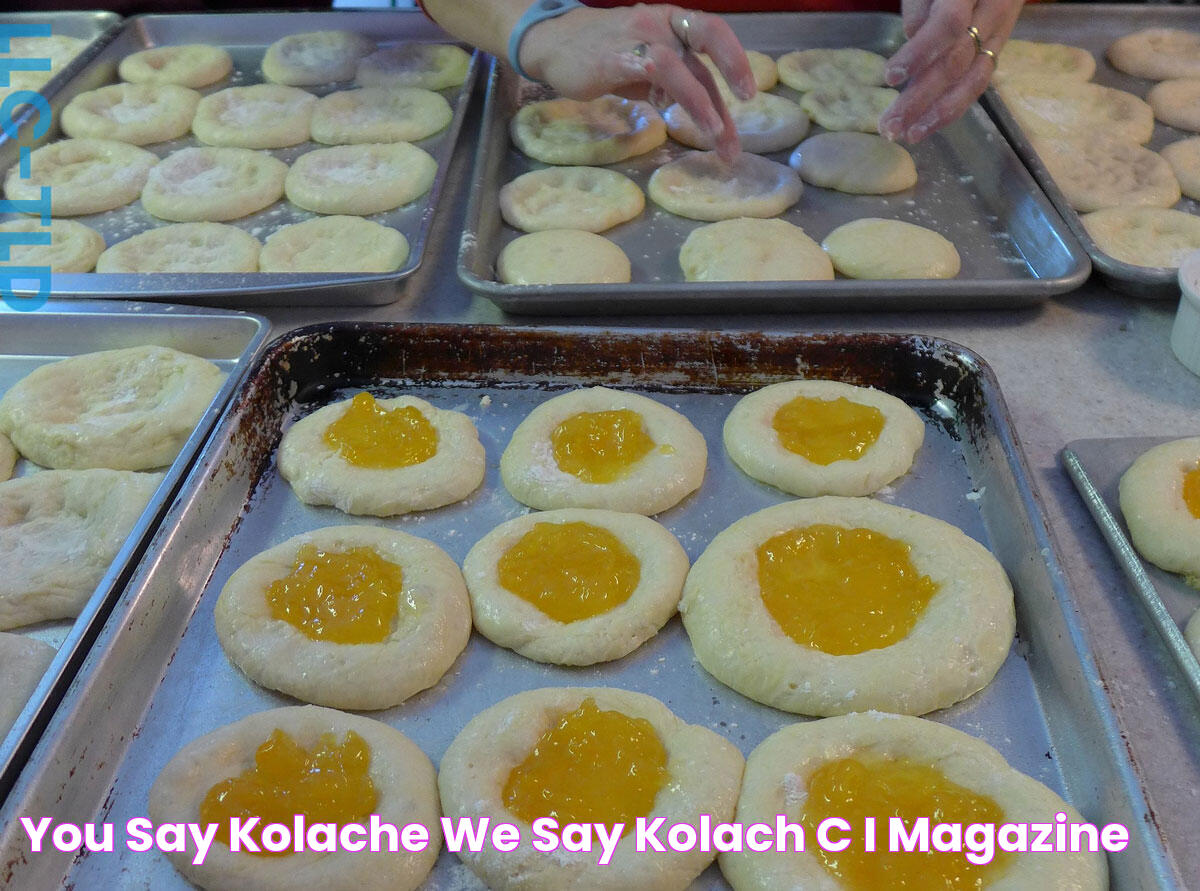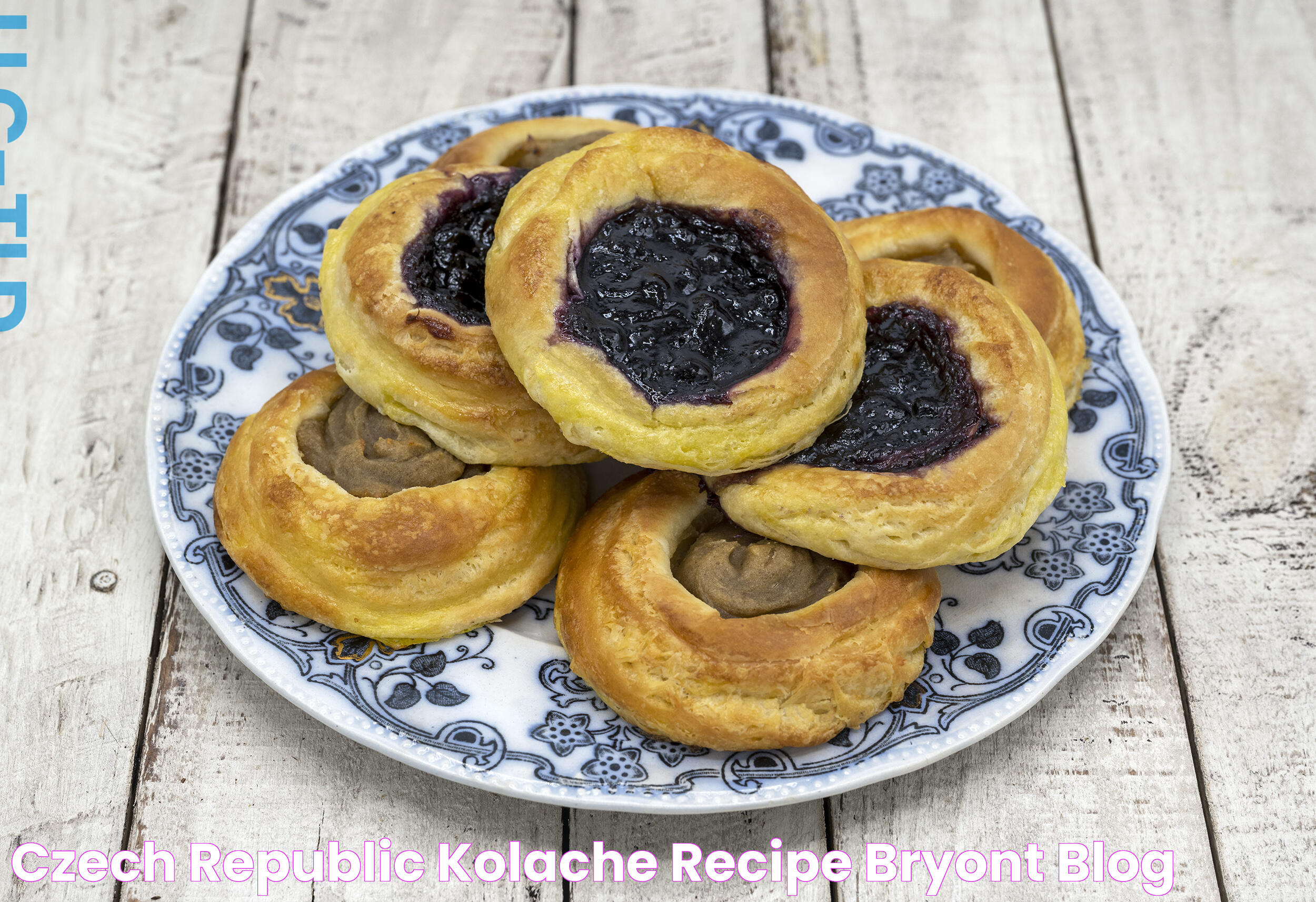The Ultimate Guide To Pronouncing "Kolache": A Comprehensive Tutorial
The correct pronunciation of "kolache" is "koh-lah-chee". It is a type of pastry that is popular in Central and Eastern Europe. Kolaches are typically made with a sweet dough that is filled with fruit, cheese, or meat. They can be baked or fried. Kolaches are a popular breakfast food, but they can also be enjoyed as a snack or dessert.
Kolaches have a long history in Central and Eastern Europe. They are thought to have originated in the Czech Republic in the 13th century. Kolaches were originally made with a simple dough that was filled with fruit. Over time, the recipe for kolaches evolved to include a variety of different fillings. Today, kolaches are made with a variety of doughs, including yeast dough, puff pastry, and shortcrust pastry. They can be filled with a variety of fruits, cheeses, and meats. Kolaches are a popular food in many countries around the world, and they are often served at special occasions.
If you are interested in trying kolaches, there are many different ways to find them. You can find kolaches at bakeries, grocery stores, and even online. You can also make your own kolaches at home. There are many different recipes for kolaches available online.
Read also:Liberty Mutual Auto Insurance Get The Coverage You Need
How to Say Kolache
The correct pronunciation of "kolache" is "koh-lah-chee". It is a type of pastry that is popular in Central and Eastern Europe. Kolaches are typically made with a sweet dough that is filled with fruit, cheese, or meat. They can be baked or fried. Kolaches are a popular breakfast food, but they can also be enjoyed as a snack or dessert.
- Origin: Kolaches originated in the Czech Republic in the 13th century.
- Pronunciation: The correct pronunciation of "kolache" is "koh-lah-chee".
- Variations: Kolaches can be made with a variety of doughs and fillings.
- Popularity: Kolaches are a popular food in many countries around the world.
- Availability: Kolaches can be found at bakeries, grocery stores, and even online.
- Versatility: Kolaches can be enjoyed for breakfast, as a snack, or as a dessert.
Kolaches are a delicious and versatile pastry that can be enjoyed by people of all ages. Whether you are looking for a quick breakfast or a sweet treat, kolaches are a great option. So next time you are at the bakery, be sure to give kolaches a try!
1. Origin
The origin of kolaches in the Czech Republic during the 13th century is deeply intertwined with the evolution of its pronunciation and spelling. As the pastry spread throughout Central and Eastern Europe over the centuries, its name underwent various adaptations to fit different languages and dialects. Understanding this historical context is crucial for grasping the nuances of pronouncing "kolache" correctly.
- Linguistic Adaptation: As kolaches became popular in different regions, their name underwent phonetic changes to conform to local pronunciations. In the Czech language, the word "kol" is pronounced with a long "o" sound, which transformed into the shorter "a" sound in "kolache" when adopted into English.
- Spelling Variations: The spelling of "kolache" has also varied over time and across different languages. In Czech, the word is spelled "kol," while in Polish it is spelled "koacz." These variations reflect the influence of different orthographic systems on the representation of the pastry's name.
- Cultural Exchange: The spread of kolaches beyond the Czech Republic facilitated cultural exchange and influenced the pronunciation of the pastry's name. As kolaches were introduced to new communities, their pronunciation was adapted to fit the local linguistic norms, resulting in variations such as "kolac" in English and "kolky" in Slovak.
- Preservation of Heritage: Despite the adaptations and variations in pronunciation, the origin of kolaches in the Czech Republic remains an important aspect of the pastry's cultural heritage. Preserving the correct pronunciation of "kolache" helps maintain a connection to its historical roots and the culinary traditions of its birthplace.
In conclusion, understanding the origin of kolaches in the Czech Republic is essential for comprehending the evolution of its pronunciation and spelling. The adaptations and variations that have occurred over time reflect the linguistic and cultural exchanges that have accompanied the spread of this beloved pastry.
2. Pronunciation
The correct pronunciation of "kolache" is crucial for understanding how to say it accurately. It establishes the foundation for effective communication and avoids misunderstandings.
- Standardization: The standardized pronunciation of "kolache" as "koh-lah-chee" ensures consistency in communication. It eliminates regional variations or colloquialisms, facilitating clear and unambiguous dialogue.
- Comprehension: Pronouncing "kolache" correctly enhances comprehension. When individuals adhere to the established pronunciation, listeners can readily understand the word being referred to, avoiding confusion or misinterpretations.
- Cultural Sensitivity: Using the correct pronunciation demonstrates respect for the cultural origins of the pastry. It acknowledges the Czech heritage of kolaches and shows an appreciation for the traditions associated with it.
- Clarity in Communication: Clear pronunciation of "kolache" promotes effective communication in various settings. Whether in a bakery, restaurant, or social gathering, pronouncing it correctly ensures that the intended message is conveyed accurately.
In conclusion, understanding the correct pronunciation of "kolache" is essential for effective communication. It ensures standardization, enhances comprehension, demonstrates cultural sensitivity, and promotes clarity in various contexts.
Read also:Discover The Extraordinary World Of Erome Makay
3. Variations
The versatility of kolaches extends beyond their pronunciation, encompassing a wide range of doughs and fillings that cater to diverse preferences and culinary traditions. Understanding these variations deepens our comprehension of "how do you say kolache" by highlighting the diverse nature of this beloved pastry.
- Dough Variations: Kolaches can be made with various doughs, including yeast dough, puff pastry, and shortcrust pastry. Each dough type imparts a unique texture and flavor to the pastry, allowing for customization based on personal preferences and regional traditions.
- Filling Diversity: The fillings used in kolaches span a vast spectrum, ranging from traditional fruit preserves like apricot and plum to savory options like cheese, meat, and sauerkraut. This diversity reflects the cultural influences and culinary creativity that have shaped the kolache over time.
- Regional Influences: The variations in dough and fillings also showcase the regional influences on kolaches. In Texas, for instance, kolaches often feature klobasniki, a type of sausage, as a popular filling. In contrast, kolaches in the Midwest might be filled with sweet fruits like blueberries or cherries.
In conclusion, the variations in doughs and fillings underscore the versatility and adaptability of kolaches. These variations contribute to the richness and diversity of the pastry, making it a beloved culinary creation that transcends linguistic and cultural boundaries.
4. Popularity
The widespread popularity of kolaches is intricately connected to the question of "how do you say kolache". This popularity transcends linguistic and cultural boundaries, making it a culinary delight enjoyed by people from diverse backgrounds.
- Global Recognition: Kolaches have gained international recognition, becoming a beloved pastry in countries such as the United States, Canada, and Australia. This global appeal stems from the versatility and adaptability of the pastry, which allows it to be enjoyed in various settings and occasions.
- Culinary Significance: In many cultures, kolaches hold significant cultural and culinary importance. In the Czech Republic, where they originated, kolaches are a cherished part of traditional cuisine and are often served during festivals and celebrations. This significance extends to other countries where kolaches have become an integral part of local foodways.
- Diverse Appeal: The popularity of kolaches lies in their ability to cater to diverse tastes and preferences. The variety of doughs and fillings allows for customization, ensuring that there is a kolache to suit every palate. This diverse appeal contributes to the widespread enjoyment of the pastry.
- Culinary Innovation: The popularity of kolaches has also fostered culinary innovation. Chefs and bakers are constantly experimenting with new flavor combinations and unique interpretations of the classic kolache. This innovation keeps the pastry fresh and exciting, contributing to its enduring appeal.
In conclusion, the popularity of kolaches worldwide is closely intertwined with the question of "how do you say kolache". The pastry's versatility, cultural significance, diverse appeal, and ability to inspire culinary innovation make it a beloved food enjoyed by people from all walks of life.
5. Availability
The availability of kolaches at various locations, including bakeries, grocery stores, and online, is intricately connected to the question of "how do you say kolache." This widespread availability underscores the popularity and accessibility of this beloved pastry.
- Convenience and Accessibility: The presence of kolaches in bakeries and grocery stores makes them easily accessible to consumers. This convenience contributes to the popularity of kolaches, as they can be purchased during regular shopping trips or as a quick snack.
- Online Presence: The availability of kolaches online further expands their reach, allowing consumers to order and have them delivered to their doorsteps. This convenience caters to busy individuals or those who prefer the comfort of online shopping.
- Increased Visibility: The widespread availability of kolaches increases their visibility and familiarity among consumers. This increased visibility contributes to the recognition and popularity of the pastry, making it a staple in many households and communities.
- Cultural Exchange: The availability of kolaches in various locations facilitates cultural exchange and the sharing of culinary traditions. As kolaches become more accessible, people from diverse backgrounds have the opportunity to experience and appreciate this unique pastry.
In conclusion, the availability of kolaches at bakeries, grocery stores, and even online is closely intertwined with the question of "how do you say kolache." This widespread availability enhances the popularity, accessibility, and visibility of the pastry, contributing to its enduring appeal and cultural significance.
6. Versatility
The versatility of kolaches, extending beyond their diverse doughs and fillings, is intricately connected to the question of "how do you say kolache". This versatility contributes to the widespread appeal and adaptability of the pastry, making it a beloved culinary creation enjoyed in various settings and times of the day.
- Breakfast Delight: Kolaches are a popular choice for breakfast, offering a delightful combination of sweet and savory flavors. Their portability and ease of consumption make them a convenient and satisfying morning meal.
- Snack Time Treat: Kolaches also serve as a perfect snack, providing a quick and tasty pick-me-up between meals. Their bite-sized nature and variety of flavors make them an ideal on-the-go snack.
- Sweet Dessert: Kolaches can transition seamlessly into the dessert realm, offering a sweet ending to any meal. Their flaky pastry and flavorful fillings create a delightful treat that satisfies any sweet tooth.
- Cultural Significance: The versatility of kolaches reflects the cultural influences that have shaped its evolution. In many cultures, kolaches hold a special place in traditional festivities and gatherings, served as a symbol of hospitality and shared enjoyment.
In conclusion, the versatility of kolaches, allowing them to be enjoyed for breakfast, as a snack, or as a dessert, is closely intertwined with the question of "how do you say kolache". This versatility underscores the enduring appeal and adaptability of the pastry, making it a cherished culinary delight that transcends cultural and linguistic boundaries.
FAQs about Kolaches
This section addresses frequently asked questions about kolaches, providing informative answers to enhance understanding.
Question 1: What is the correct pronunciation of "kolache"?
Answer: The correct pronunciation is "koh-lah-chee," with a short "o" and a long "a."
Question 2: Where did kolaches originate?
Answer: Kolaches originated in the Czech Republic in the 13th century.
Question 3: What are kolaches typically made of?
Answer: Kolaches are typically made with a sweet dough that is filled with fruit, cheese, or meat. They can be baked or fried.
Question 4: Are kolaches popular outside of the Czech Republic?
Answer: Yes, kolaches are popular in many countries around the world, including the United States, Canada, and Australia.
Question 5: What are some popular fillings for kolaches?
Answer: Some popular fillings for kolaches include apricot, plum, cheese, sausage, and sauerkraut.
Question 6: Can kolaches be made at home?
Answer: Yes, kolaches can be made at home. There are many recipes available online.
Summary: Kolaches are a delicious and versatile pastry that can be enjoyed for breakfast, as a snack, or as a dessert. They are a popular food in many countries around the world and can be made at home with relative ease.
Transition: To delve deeper into the fascinating world of kolaches, let's explore their rich history and cultural significance.
Tips on Pronouncing "Kolache"
Mastering the correct pronunciation of "kolache" not only enhances communication but also demonstrates respect for the pastry's cultural heritage.
Tip 1: Break it Down: Divide the word into syllables, "ko-lah-chee". Focus on pronouncing each syllable clearly and distinctly.
Tip 2: Emphasize the "A": The second syllable, "lah", should be pronounced with a long "a" sound, as in "father". Avoid shortening the sound to "la".
Tip 3: Shorten the "O": The first syllable, "ko", should have a short "o" sound, as in "cot". Refrain from pronouncing it like the long "o" in "cone".
Tip 4: Practice Regularly: Repetition is key to improving pronunciation. Practice saying "kolache" aloud, paying attention to the correct vowel sounds and syllable emphasis.
Tip 5: Listen to Native Speakers: Seek opportunities to listen to native Czech speakers pronouncing "kolache". This immersion can help refine your pronunciation and intonation.
Tip 6: Use Online Resources: Utilize online pronunciation guides and dictionaries to hear the correct pronunciation of "kolache". These resources provide auditory examples and slow-motion breakdowns.
Tip 7: Immerse Yourself in Czech Culture: Engage with Czech culture through films, music, or literature. This exposure can enhance your understanding of the language's rhythm and pronunciation patterns.
Tip 8: Don't be Afraid to Ask: If you're unsure about the pronunciation, don't hesitate to ask a native speaker or a knowledgeable person for guidance.
Summary: Pronouncing "kolache" correctly requires attention to vowel sounds, syllable emphasis, and practice. By following these tips, you can master the pronunciation of this beloved pastry's name and appreciate its cultural significance.
Transition: Delving into the rich history of kolaches unveils the origins and evolution of this delectable treat.
Conclusion on the Pronunciation of "Kolache"
Our exploration of "how do you say kolache" has shed light on the intricacies of pronouncing this beloved pastry's name. Mastering its correct pronunciation not only enhances communication but also demonstrates respect for its cultural heritage.
Understanding the origin of kolaches in the Czech Republic provides a foundation for appreciating the evolution of its pronunciation. Breaking down the word into syllables and emphasizing the correct vowel sounds are crucial for accurate pronunciation. Regular practice, immersion in Czech culture, and seeking guidance from native speakers can further refine one's pronunciation.
Beyond its pronunciation, the versatility and popularity of kolaches make them a culinary delight enjoyed worldwide. Their diverse doughs, fillings, and availability in various settings contribute to their enduring appeal. Understanding "how do you say kolache" not only enhances our appreciation for this pastry but also opens a door to exploring its rich cultural significance.
As we continue to savor the flavors of kolaches, let us also celebrate the diversity of languages and cultures that enrich our culinary experiences. Preserving and sharing the correct pronunciation of "kolache" is a testament to our respect for tradition and our commitment to fostering cultural understanding.
Discover The Enchanting Chincoteague Inn - Your Gateway To Paradise
5 Acne Dairy Allergy Symptoms You Need To Know
Is Robert Redford White? Discover The Truth Here!


